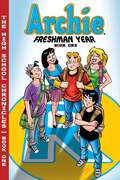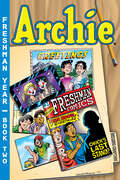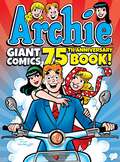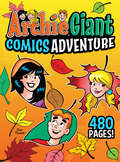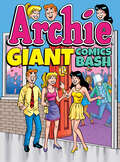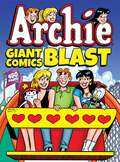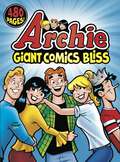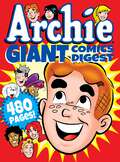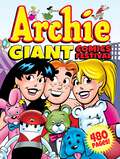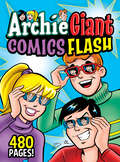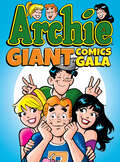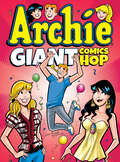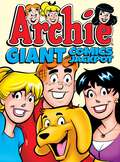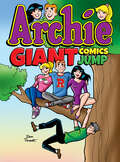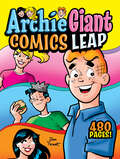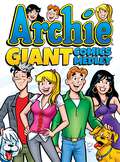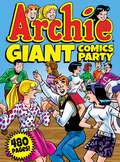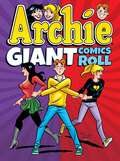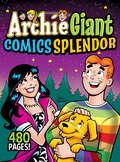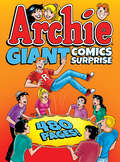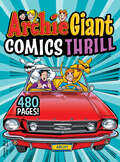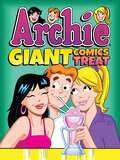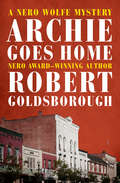- Table View
- List View
Archie Freshman Year Book 1
by Batton LashArchie and his friends have forever been stuck in the latter portion of high school, but now, after many long years, the story of how "the gang" all met up is finally being told in this, the first edition of The High School Chronicles! This pioneering storyline brings us the beginning of the "eternal love triangle," the introduction of Mr. Weatherbee as principal of Riverdale High, the formation of Moose and Midge's relationship (and Reggie's subsequent schemes to split them up), and other Archie staples! So get your Homecoming dress, pack your brand-new backpack, and pick up your school map to find your way to the biggest Archie story of the year!
Archie Freshman Year Book 2
by Batton LashBefore they ruled Riverdale High, they were freshmen too!Go back to school with Archie, Reggie, Betty, Veronica, Chuck and Jughead and see how it all began! Find out what happens when Jughead finds true love! Watch as Betty & Veronica become accidental internet celebrities. Witness Reggie leaving the Gang for a new set of &“Pals &‘n&’ Gals.&” See what develops as Chuck takes on the world of comic books for the very first time, and find out what exactly happened to Pencilneck G. Get the full story for the first time!
Archie Giant Comics 75th Anniversary Book (Archie Giant Comics Digests #8)
by Archie SuperstarsARCHIE GIANT COMICS 75TH ANNIVERSARY BOOK collects 480 pages of iconic Archie tales in this one amazing volume! Follow America's favorite red-head as he navigates the pressures of the American teenager in the awkward, charming, and hilarious way you've come to know and love.
Archie Giant Comics Adventure (Archie Giant Comics #19)
by Archie SuperstarsGet ready for a wild ADVENTURE with Archie and the Gang in this 480-page collection. This volume collects 480 pages of iconic Archie comic stories, featuring the same mix of wild humor, awkward charm and genuine relatability that has kept Archie and the gang popular with kids and families for 80 years.
Archie Giant Comics Bash (Archie Giant Comics Digests #13)
by Archie SuperstarsARCHIE GIANT COMICS BASH offers popular, proven full-color content at the same price and page count as most black-and-white mass-market paperbacks. This is the next volume of our new series of super-value Archie comics collections featuring 480 pages of stories in the same format as our #1 best-selling Archie Digest kids' magazine series and 1000 Page Digest book series. Designed for venues dedicated to offering customers the best value in kids' books today at an affordable price, such as grocery stores, drug stores, and mass merchants, as well as traditional book outlets.This volume collects 480 pages of iconic Archie comic stories, featuring the same mix of wild humor, awkward charm and genuine relatability that has kept Archie and the gang popular with kids and families for 75+ years.
Archie Giant Comics Blast (Archie Giant Comics Digests)
by Archie SuperstarsARCHIE GIANT COMICS BLAST collects 480 pages of iconic Archie tales in this one amazing volume! Follow America's favorite red-head as he navigates the pressures of the American teenager in the awkward, charming, and hilarious way you've come to know and love.
Archie Giant Comics Bliss (Archie Giant Comics #25)
by Archie SuperstarsArchie Giant Comics Bliss collects 480 pages of iconic Archie tales in one amazing volume! Follow America's favorite red-head as he navigates the pressures of the American teenager in the awkward, charming, and hilarious way you've come to know and love.
Archie Giant Comics Collection (Archie Giant Comics Digests #4)
by Archie SuperstarsARCHIE GIANT COMICS COLLECTION collects 480 pages of iconic Archie tales in this one amazing volume! Follow America's favorite red-head as he navigates the pressures of the American teenager in the awkward, charming, and hilarious way you've come to know and love.
Archie Giant Comics Digest (Archie Giant Comics Digests #1)
by Archie SuperstarsArchie is for everyone!Get ready to have a blast with Archie, Jughead, Betty & Veronica in this giant-sized collection, filled with over 400 full-color pages of stories by Archie legends including Dan DeCarlo, George Gladir, Fernando Ruiz and Dan Parent!
Archie Giant Comics Festival (Archie Giant Comics Digests #2)
by Archie SuperstarsGet ready for a giant-sized festival of fun with over 400 full-color pages of comics by Archie legends including Dan DeCarlo, George Gladir, Fernando Ruiz and Dan Parent! So what are you waiting for? Open the book and prepare to have the time of your life with Archie, Jughead, Betty & Veronica!
Archie Giant Comics Flash (Archie Giant Comics Digests #21)
by Archie SuperstarsARCHIE GIANT COMICS FLASH offers popular, proven full-color content at the same price and page count as most black-and-white mass-market paperbacks. This is the next volume of our new series of super-value Archie comics collections featuring 480 pages of stories in the same format as our #1 best-selling Archie Digest kids' magazine series and 1000 Page Digest book series. Designed for venues dedicated to offering customers the best value in kids' books today at an affordable price, such as grocery stores, drug stores, and mass merchants, as well as traditional book outlets.This volume collects 480 pages of iconic Archie comic stories, featuring the same mix of wild humor, awkward charm and genuine relatability that has kept Archie and the gang popular with kids and families for 80 years.
Archie Giant Comics Gala (Archie Giant Comics Digests #14)
by Archie SuperstarsARCHIE GIANT COMICS GALA offers popular, proven full-color content at the same price and page count as most black-and-white mass-market paperbacks. This is the next volume of our new series of super-value Archie comics collections featuring 480 pages of stories in the same format as our #1 best-selling Archie Digest kids' magazine series and 1000 Page Digest book series. Designed for venues dedicated to offering customers the best value in kids' books today at an affordable price, such as grocery stores, drug stores, and mass merchants, as well as traditional book outlets.This volume collects 480 pages of iconic Archie comic stories, featuring the same mix of wild humor, awkward charm and genuine relatability that has kept Archie and the gang popular with kids and families for 75+ years.
Archie Giant Comics Hop (Archie Giant Comics Digests #15)
by Archie SuperstarsARCHIE GIANT COMICS HOP offers popular, proven full-color content at the same price and page count as most black-and-white mass-market paperbacks. This is the next volume of our new series of super-value Archie comics collections featuring 480 pages of stories in the same format as our #1 best-selling Archie Digest kids' magazine series and 1000 Page Digest book series. Designed for venues dedicated to offering customers the best value in kids' books today at an affordable price, such as grocery stores, drug stores, and mass merchants, as well as traditional book outlets.This volume collects 480 pages of iconic Archie comic stories, featuring the same mix of wild humor, awkward charm and genuine relatability that has kept Archie and the gang popular with kids and families for 75+ years.
Archie Giant Comics Jackpot! (Archie Giant Comics Digests #6)
by Archie SuperstarsARCHIE GIANT COMICS JACKPOT! collects 480 pages of iconic Archie tales in this one amazing volume! Follow America's favorite red-head as he navigates the pressures of the American teenager in the awkward, charming, and hilarious way you've come to know and love.
Archie Giant Comics Jump (Archie Giant Comics #1)
by Archie SuperstarsJUMP into the fun in this all-new collection of some of Archie’s most hilarious and entertaining stories! This volume collects 480 pages of iconic Archie comic stories, featuring the same mix of wild humor, awkward charm and genuine relatability that has kept Archie and the gang popular with kids and families for 75+ years.
Archie Giant Comics Leap (Archie Giant Comics Leap #17)
by Archie SuperstarsArchie’s best-selling, binge-reading GIANT collection of comics is back! Take a leap with Archie and join our redheaded hero for some Riverdale fun along with his best pals Jughead, Betty, Veronica and more in this jumbo-sized compendium of tales! Get ready for hours upon hours of classic Archie fun, complete with dating drama, high school hilarity, and chockli’t shoppe shenanigans!
Archie Giant Comics Medley (Archie Giant Comics Digests #8)
by Archie SuperstarsARCHIE GIANT COMICS MEDLEY collects 480 pages of iconic Archie tales in this one amazing volume! Follow America's favorite red-head as he navigates the pressures of the American teenager in the awkward, charming, and hilarious way you've come to know and love.
Archie Giant Comics Party (Archie Giant Comics Digests #3)
by Archie SuperstarsARCHIE GIANT COMICS PARTY collects 480 pages of iconic Archie tales in this one amazing volume! Follow America's favorite red-head as he navigates the pressures of the American teenager in the awkward, charming, and hilarious way you've come to know and love.
Archie Giant Comics Roll (Archie Giant Comics Digests #11)
by Archie SuperstarsARCHIE GIANT COMICS ROLL collects 480 pages of iconic Archie tales in this one amazing volume! Follow America's favorite red-head as he navigates the pressures of the American teenager in the awkward, charming, and hilarious way you've come to know and love.
Archie Giant Comics Splendor (Archie Giant Comics #20)
by Archie SuperstarsExperience all the splendor of reading Archie Comics with this over-sized, full-color collection of some of the funniest and most entertaining Archie stories, featuring the same mix of wild humor, awkward charm and genuine relatability that has kept Archie and the gang popular with kids and families for 80 years.
Archie Giant Comics Spotlight (Archie Giant Comics Digests #5)
by Archie SuperstarsARCHIE GIANT COMICS SPOTLIGHT collects 480 pages of iconic Archie tales in this one amazing volume! Follow America's favorite red-head as he navigates the pressures of the American teenager in the awkward, charming, and hilarious way you've come to know and love.
Archie Giant Comics Surprise (Archie Giant Comics Digests #12)
by Archie SuperstarsARCHIE GIANT COMICS SURPRISE offers popular, proven full-color content at the same price and page count as most black-and-white mass-market paperbacks. This is the next volume of our new series of super-value Archie comics collections featuring 480 pages of stories in the same format as our #1 best-selling Archie Digest kids' magazine series and 1000 Page Digest book series. Designed for venues dedicated to offering customers the best value in kids' books today at an affordable price, such as grocery stores, drug stores, and mass merchants, as well as traditional book outlets.This volume collects 480 pages of iconic Archie comic stories, featuring the same mix of wild humor, awkward charm and genuine relatability that has kept Archie and the gang popular with kids and families for 75+ years.
Archie Giant Comics Thrill (Archie Giant Comics Digests #18)
by Archie SuperstarsARCHIE GIANT COMICS THRILL offers popular, proven full-color content at the same price and page count as most black-and-white mass-market paperbacks. This is the next volume of our new series of super-value Archie comics collections featuring 480 pages of stories in the same format as our #1 best-selling Archie Digest kids' magazine series and 1000 Page Digest book series. Designed for venues dedicated to offering customers the best value in kids' books today at an affordable price, such as grocery stores, drug stores, and mass merchants, as well as traditional book outlets.This volume collects 480 pages of iconic Archie comic stories, featuring the same mix of wild humor, awkward charm and genuine relatability that has kept Archie and the gang popular with kids and families for 80 years.
Archie Giant Comics Treat (Archie Giant Comics Digests #9)
by Archie SuperstarsARCHIE GIANT COMICS TREAT collects 480 pages of iconic Archie tales in this one amazing volume! Follow America's favorite red-head as he navigates the pressures of the American teenager in the awkward, charming, and hilarious way you've come to know and love.
Archie Goes Home (The Nero Wolfe Mysteries #15)
by Robert GoldsboroughArchie Goodwin leaves Manhattan for the Midwest to find out who put a bullet into a banker. Archie Goodwin&’s aunt Edna is about to lure him away from his work at Nero Wolfe&’s New York brownstone. After a phone call, he heads off to Ohio, where the president of Farmer&’s State Bank and Trust, an elderly widower, has died in an apparent suicide. But Archie&’s aunt has expressed nagging suspicions—which only grow stronger when someone takes a shot at a local reporter who wrote about the case. It wouldn&’t be a small town without some gossip, and Archie soon hears the whispers: romantic intrigues, a possible paternity case, a ruined business. While reconnecting with his aging mother—and fending off his nagging aunt—Archie tries to untangle a web of grudges, scandals, and murder. From Nero Award winner Robert Goldsborough, this is a brand-new novel in the series created by Rex Stout, starring one of the world&’s most beloved detectives and his equally engaging sidekick. Archie Goes Home is the 15th book in the Nero Wolfe Mysteries, but you may enjoy reading the series in any order.
